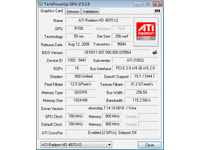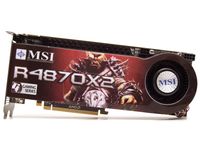Radeon HD 4870 X2: Four Cards Compared
MSI Radeon HD 4870 X2 OC Edition (R4870X2-T2D2G-OC)
For many users, the operating temperature of the single-chip Radeon HD 4870 was way too high and if you didn’t like the heat, you had to manually adjust the fan speed and flash the BIOS with your own settings. MSI noticed this problem and shipped its OC edition with an improved fan profile, resulting in higher fan speeds for lower temperatures.
The dual-chip Radeon HD 4870 X2 OC has different fan settings that result in varying noise levels and temperatures compared to the rest of the test group. In 2D mode, the card cools down to 43°C, but you will constantly hear 52.2 dB(A) of noise. The other X2 cards are significantly quieter, but heat up to levels of 64 to 78 degrees. The fan speed doesn’t change in 3D mode, where the temperature is held to between 76°C and 80°C. If the graphic chip crosses the 80 degree threshold, the fan speeds up significantly, roaring at 62.2 dB(A) until the temperature goes below the threshold again.


The standard fan speed for 2D operation is 27% at about 1,400 RPM, whereas MSI brings it up to 50% or 3,200 RPM. Under 3D load, the fan speed ranges between 3,400 and 3,900 RPM, and above 80°C it runs at 100% and 4,800 RPM. After cooling down, the fan speed drops to 3,200 RPM until it reaches the critical temperature threshold once again.
At first this sounds drastic, but the advantage of this setup is that nothing changes from overclocking and the temperatures never go into the critical range. MSI only slightly overclocks the OC edition. Its GPU speed was increased from 750 MHz to 780 MHz and the graphics memory stays the same at a standard setting of 900 MHz. In our tests, the GPU can easily handle 800 MHz, which unfortunately is the limit in the driver menu—if you want more, you will have to use ATI Tool or Riva Tuner. The graphics memory can take 965 MHz, which is an acceptable value. At 970 MHz, we started to see our first image errors.
There aren’t that many accessories here, including no games (despite MSI advertising the card as a “Gaming Series”). The CrossFire bridge and the DVI-to-HDMI adapter are included.
Our same disclaimer covering overclocking applies here. Take the board over MSI’s factory settings and you risk forgoing support in the event of an issue.
MSI Radeon HD 4870 X2 OC Edition
Get Tom's Hardware's best news and in-depth reviews, straight to your inbox.
A loud, but cool, dual-chip Radeon HD 4870 X2 card. Overclocking shouldn’t lead to overheating because of the high fan speeds. There aren’t that many accessories; it doesn’t come with any games despite being called the “Gaming Series.”
- Advantages
- Disadvantages
- Good overclocking potentialCool, though loud
- Loud, though cool
Current page: MSI Radeon HD 4870 X2 OC Edition (R4870X2-T2D2G-OC)
Prev Page Software HIS Radeon HD 4870 X2 Next Page Software MSI Radeon HD 4870 X2 OC Edition-
Not only do we have four super-fast Radeon HD 4870 X2s to test, but also a list of 31 other graphics configurations including CrossFire and SLI setups. If you're in the market for AMD's fastest card available, you'll want to see this.Reply
Radeon HD 4870 X2: Four Cards Compared : Read more -
neiroatopelcc "Because of accessories and price, Sapphire is our best-buy recommendation."Reply
One slight warning about sapphire though. If you have problems, don't expect their support team to help you before you've solved the problem yourself!
I made a ticket regarding some issues with my 4870 on august 7th, and received a reply on the 26th of september! That's 46 days to address an error they simply stated would go away with a bios upgrade from their homepage!
As for the article, I actually liked the detailed driver errors they encountered. Not that I liked the errors themselves, but I liked them being explained. Usually you just read 'after spending some hours resolving driver errors ....' without getting any wiser. -
Pei-chen Wow, AMD cards consume power like a Detroit SUV. I like Nvidia GTX 2xx series’ Toyota Prius like efficiency at idle.Reply -
ilovebarny Why didnt they use the GTX260 Core 216? its like way better than the regular GTX260. And i just read yesterday that Nvidia was only going to make GTX260 Core 216 now. http://www.fudzilla.com/index.php?option=com_content&task=view&id=10497&Itemid=1Reply -
enforcer22 Pei-chenWow, AMD cards consume power like a Detroit SUV. I like Nvidia GTX 2xx series’ Toyota Prius like efficiency at idle.Reply
Hmm your right. Power house vs crippled mouse.. yeah your analagy sucked im sure mine did to but all i saw from what you typed was i like weak stuff dont give me more power. -
bdollar seems to me if you are going to be comparing the highest end cards and even crossfire them for 4x you would have the highest resolution as one of the options. i would think people considering going x2 in crossfire would consider a 30" screen.Reply
don't get me wrong, i liked the article but would have liked to have seen the resolution spectrum hit the top. -
It's nice to see the 9800GX2 included in the tests. I was considering the 4870x2 due to all the rave reviews but they never had the comparison like this against my current 9800GX2. I won't be getting new card anytime soon it seems. Thanks.Reply


